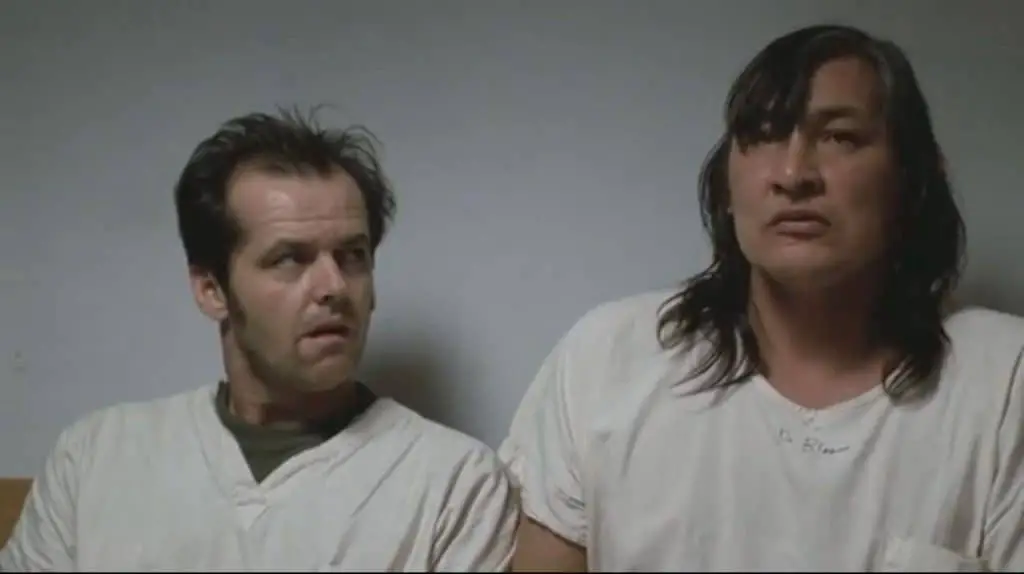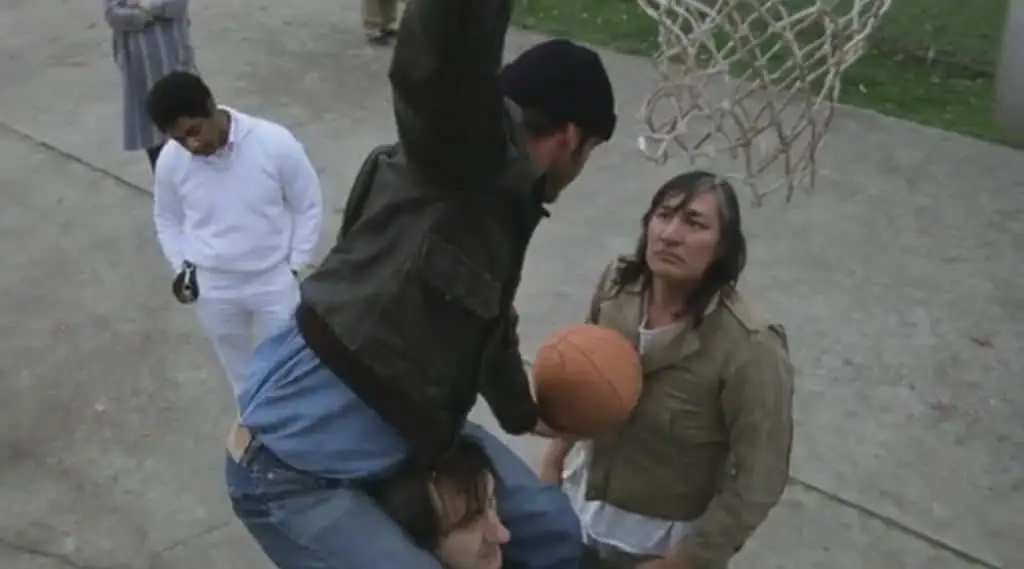Nuances of Milos Forman’s film “One Flew Over the Cuckoo’s Nest”
The novel, written in 1962 and immediately became the “Hippie Bible”, was filmed 13 years later. The film won 5 Oscars and 5 Golden Globe Awards.
The meaning of the name
The title cites an excerpt from a children’s counting room that the Indian Bromden heard from his grandmother.
Ting. Tingle, tingle, tremble toes, she’s a good fisherman, catches hens, puts ’em inna pens… wire blier, limber lock, three geese inna flock… one flew east, one flew west, one flew over the cuckoo’s nest… O-U-T spells out… goose swoops down and plucks you out.
Viktor Golyshev, translating the novel into Russian, sent one of the geese out of the house, and the other in the house to rhyme with an oxymoron “over the cuckoo’s nest.” In the original, one of the geese flew to the east, another to the west, and the third flew over the cuckoo’s nest – this is the interlinear.

Perhaps, for the director Milos Forman, almost on the eve of the filming of the film who fled from the socialist East to the capitalist West, this geographical alternative is not just two opposite directions, but also the political aspect of the choice.
Other phrases reading out can also serve as a key to deciphering the text of the novel. She’s a good fisherman – of course, who is a good fisherman here: the Elder Sister, the ruler over the bodies and souls of patients. Catches hens (catching chickens) are group therapy sessions where patients are forced to divulge their intimate secrets and are pitted against each other by a nurse. What is not cockfighting, when, at the sight of a drop of blood, the cock pounces on the enemy and pecks him at the most sore spot.

Why is the “cuckoo’s nest”, after all, the cuckoo does not build it? That’s why. Something that doesn’t exist. In addition, the Americans call mental hospitals cuckoo nests. To fly over such a place and not land in it means to gain freedom. This is what the protagonist tried to do, where he tried to drag his “comrades-in-arms” through the hospital wards until he underwent a lobotomy.
What a terrible lobotomy?
The heyday of this brain-crushing procedure came in the 30s of the twentieth century, when the Portuguese Egash Moniz came up with it. This “progressive” doctor made a small hole in the patient’s skull and inserted a wire with a loop into it. He twisted and twisted a piece of iron in the poor fellow’s brains, thereby breaking the connection between the frontal lobes of the brain and all the other lobes. The process was called beautifully: prefrontal leucotomy. After such a blending of the contents of the skull, the patient became obedient. True, in intelligence he was adequate to a two-year-old child, but on the other hand he was controllable! Even President Kennedy’s sister has undergone a similar beneficial operation. The twenty-year-old lady was cocky, with the tendencies of a nymphomaniac. After the lobotomy, the disfigured girl got into a wheelchair – and so she lived her long life as a brainless vegetable.
The most interesting thing that Moniz received in 1949 for his discovery … attention, now there will be a drum roll: the Nobel Prize !!! Yes! Relatives of disabled patients have repeatedly raised the issue of depriving the doctor of the award, but where there … The Nobel Committee does not cancel its decisions.
In our enlightened times, it is believed that lobotomy is a dead-end branch of evolution in psychiatry, but once this operation was routine – like blowing your nose. First, quickly. Secondly, it’s easy. The process was further refined by Walter Freeman. The piece of iron was pushed through the eye socket. No holes in the skull. Have a little brains – and voila. A helpful, quiet, uncomplaining member of society at your service.

Lobotomy by 1962, when Ken Kesey’s novel was written, had already gone out of fashion and ceased to be a mass operation. However, in the hospital where the film was filmed, the last such surgical intervention took place in 1958, not so far from 1962.
Why writer Ken Kesey never watched the movie?
The Creator is a vulnerable being. Well, who will be happy if your idea is taken and twisted. In the book, the whole story is recounted by a huge representative of the indigenous nationality of the United States, over whom they were not weak in the clinic: 200 sessions of electroshock are not a joke to you.
Either the permanent electroshock is the reason, or the voices of the ancestors, but the Indian Bromden considers himself a psychic, penetrating into the essence of things. It’s in the book. In the film, Bromden is just a silent mountain with a mop, and the only protagonist is Randall Patrick McMurphy. Moreover, in the film McMurphy is a charismatic, friendly, but still a criminal and slob, and not the personification of the fiery-haired Christ sacrificing himself to the flock, as in the book.

In the novel, we see everything that happens through the eyes of Bromden. He interprets the hospital as a monstrous Combine, where the all-seeing Big Sister (an analogue of Big Brother from George Orwell’s dystopia “1984”) breaks people one by one, and the “fog machine” covers the sufferers with smoke.
In the film, everything is not so infernal. We look with our own eyes (and not through the eyes of an Indian nicknamed the Chief) at an ordinary clinic for the mentally ill, where everything is quite tolerant until punitive measures begin after the attempted murder of Miss Ratchet.
However, Ken Kesey never won the court against the authors of the film. And should he have acted according to the well-known principle of our public: “I have not read, but I condemn”? One day Ken had the opportunity to watch the film adaptation, when he, switching channels, stumbled upon an already running movie. But, realizing what was happening on the screen, the writer immediately turned off the TV.
How director Milos Forman rearranged the accents in the film?
Literature and cinema are two different things. Figurative means are from dissimilar arsenals. There is no film adaptation that translates verbal language into visual language with absolute accuracy. An attempt to introduce a voice-over author’s voice into the film adaptation is generally a primitive technique generated by helplessness. Yes, the best films are based on novels. And there are two reasons why such films immediately fall into the category of popular ones.
- Only novels tested by time and by the reader’s reaction are subjected to screen adaptations. Nobody will make a film based on graphomaniac nonsense.
- Viewers are interested in plunging back into the atmosphere of the book and comparing the image formed in their imagination with the image created by the filmmaker and film crew.
“Passions-muzzles” (we will borrow the apt term from Maxim Gorky), which arose in the brain of an inadequate Indian talking about his stay in a madhouse, revealed a depressing picture of the Combine suppressing the will of people. Big Nurse is an ugly, powerful aunt, a monster that smashes both patients and orderlies to the right and left. In the film, Miss Ratchet is a neat, pretty lady, a strict, imperturbable professional who performs her duties with excessive zeal.

She sincerely believes that “carefully thought out order” should not be violated for the sake of some baseball on TV, and about the “crime” of young Billy Bibbit, by all means, it is necessary to inform the mother.
Who changed communication with McMurphy?
The Big Nurse hasn’t changed in the neck brace, worn after McMurphy’s attempt to avenge Billy’s death. The Iron Lady stayed with it.
Billy changed for one night and a few minutes of triumph when his friends applauded him. I even stopped stuttering.
– Mack, I will miss you…
– So come with me Billy, let’s leave together!
– No, Mac. I am not ready…
Never again will the unfortunate boy be ready to leave the insane asylum, because he passed away, killed by the reinforced concrete principles of the Big Sister – the best friend of his oppressive mother, who pushed her son into the “cuckoo’s nest.”
The patients changed as they smelled freedom from Randall, took a breeze fishing trip, took a walk at the last party. How long?
Only Chieftain Bromden found freedom, having knocked out a window and followed the path once shown by a deceased friend.
“I remember doing huge jumps on the run, and it seemed to me that it took too long for my foot to touch the ground again. I felt like I was flying. Free. “







